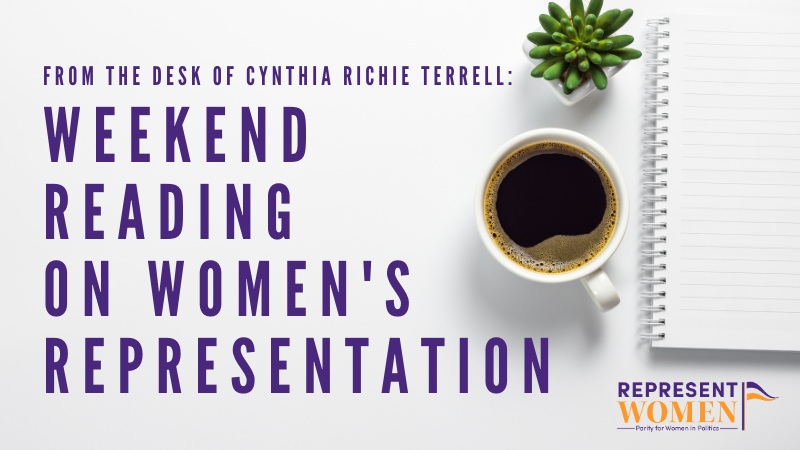
Weekend Reading on Women’s Representation is a compilation of stories about women’s representation in politics, on boards, in sports and entertainment, in judicial offices and in the private sector in the U.S. and around the world—with a little gardening and goodwill mixed in for refreshment!
How it started: How it’s going: pic.twitter.com/QKCAGfb8aR
— Paralympic Games (@Paralympics) August 30, 2021
The 2020 Paralympic Games are underway in Tokyo this week with impressive wins for women in many different competitions. High numbers of women competing and winning in athletics, however, does not of course reflect women’s representation in politics or government. While this is true the world over it’s especially pertinent in the United States where very few disabled women serve in elected office.
According to a new report from RepresentWomen, 16 percent of women identify as living with a disability yet only 3 percent of women elected officials identify as disabled. ReflectUS CEO Tiffany Gardner, fellow ReflectUS board member Erin Loos Cutraro and I co-authored a piece in Ms. about the barriers disabled women face in politics and best practices—like #CamelCase hashtags—to address those barriers so we can achieve a #21stCenturyDemocracy that reflects all of us:
Last month we celebrated Disability Pride—a time to honor difference, raise awareness and promote visibility for disabled Americans. The Americans with Disability Act (ADA) was passed in July 1990, providing legal avenues for access to spaces and opportunities for those with disabilities. Yet 31 years after this historic law was passed, American women with disabilities continue to fight for an equal voice and opportunities for representation.
According to recent research, in 26 states, there is no known disabled person elected at the local, state or national level. More concerning, women with disabilities are elected in only 15 states. In fact, disabled women represent only 2.9 percent of all elected officials, while 16.1 percent of U.S. women are disabled. As organizations and leaders advocate to increase women’s political leadership, it is imperative that we include women from diverse backgrounds and experiences in this work. Our government and society need women with different lived experiences to be active members of decision-making bodies.
The ReflectUS Coalition and its members have been working towards this goal for various communities of women, including disabled women. Recently, ReflectUS Coalition members RepresentWomen and She Should Run have worked directly on this important issue through research and training opportunities.
Representation matters across all sectors and disciplines, but this powerful article in Fast Company by Maria Kuhn and Hana Schank makes clear that the absence of women in the safety testing of vehicles is a matter of life and death. Women are 72 percent more likely than men to be injured in a car crash, yet there is no requirement to include women in the safety testing process:
In July 2019, my coauthor Hana was hit head on by a passenger truck attempting to pass in a no-passing zone. The whole family was seriously injured, but most of all the female passengers, whose spines were fractured and intestines torn. Halfway across the world and five months later to the day, a distracted driver jumped lanes and smashed into me. In that crash too, I and the other women in the car suffered a ruptured intestine and broken bones, while the men walked away mostly unharmed. By the time Hana and I found each other a year later, united by a search for answers, more than 400,000 women had been severely injured by motor vehicles.
What we didn’t know at the time was that our shared trauma was not unique—the sisterhood of vehicle-crash victims is farther reaching than we realized. Mothers and daughters are bonded not by stories and laughs, but by traumatic brain injuries, permanent scars, and moments of horror sealed into memory.
In 2019, 10,420 women died from motor vehicle crashes, and over 1 million sustained injuries. While men are more likely to cause crashes, women are more likely to die in them. None of this is surprising to car manufacturers or the government agency responsible for car safety standards, both of which have known these statistics for decades. While bias plagues many of our nation’s institutions, perhaps none are as shocking as a government- and industry-sanctioned practice that protects men and kills or seriously injures the other 50% of the population. The government’s long-acknowledged negligence bears the responsibility, while women and their families carry the consequences.
Every car that receives a safety rating from the National Highway Safety Transportation Association (NHSTA)—the nation’s safety rating agency—undergoes four tests. Intended to mimic the impact of frontal, rollover, side, and side pole crashes, these tests represent the standard to which automakers design their cars. Even though women are 72% more likely to be injured, and 17% more likely to die in a car crash than men, the frontal crash test the agency requires is only performed using a male driver. There is no mandated test that simulates a female driver.
For tests with women in the passenger seat, the dummy used to represent women is merely a scaled down male—4’11”, 108 pounds, and lacking any sort of internal morphology that distinguishes between sexes. Unaccounted for are the varying bone densities, muscle structures, and abdominal and chest physiologies that differentiate women from a male dummy. For example, the neck musculature of an average woman contains far less column strength and muscle mass than a man’s, making women 22.1% more likely to suffer a head injury than men. The current standards are designed to prevent men’s heads from smashing into the dashboard and do that quite effectively, reducing 70% of whiplash in men. For women, however, the seatbelts and airbags that protect men can actually cause additional injury. Both of us have permanent scars from the seatbelts we were raised to believe would save our lives, but which also nearly ended them.
Regulators have known for over 40 years that the internal structures of women put them at greater risk than men. In 1980, based on the recommendation of a team of researchers at the University of Michigan, NHSTA prepared to create a family of dummies that would have included a true female representation. When the Reagan administration came into power in 1981, the agency’s budget was slashed along with many other cuts to the federal government—the accurate female dummy was a casualty of those cuts.
Industry data shows that part of the reason women are at greater risk than men is that we tend to drive smaller, lighter vehicles, while men gravitate toward bigger cars and trucks. The industry knows that heavy passenger trucks put women at tremendous risk—a 1988 Oxford University study found conclusively that the “principal determinant of death is the weight of the vehicle concerned.” Heavy vehicles are also a greater threat to pedestrians than small cars—and pedestrians are more likely to be women or people of color. But the motor vehicle industry, untethered by government regulations, keeps building bigger and more lethal cars, putting more female lives at risk for the sake of men’s enjoyment and their own profit. The Ford F-Series truck is currently the best selling vehicle in the nation, clocking in at 5,605 pounds.
Even worse, the automobile industry is only one example of how women are often erased from critical design decisions. As Caroline Criado Perez notes in the book Invisible Women, countless products from smartphones to stoves are developed without women in mind. Often, this is a failure of omission rather than a purposeful exclusion. The people sitting around the table in most transportation, engineering, and automotive conversations are men. Unless someone happens to ask about women, we are simply treated as an afterthought. This failure affects women’s lives on a similarly grand scale: It makes us poorer, sicker, and, when it comes to cars, is killing us.

Former Vermont Secretary of State Deb Markowitz, who now leads the Nature Conservancy in Massachusetts, reflects on the importance of women’s leadership in the nonprofit world in this interview in Philanthropy Women:
How does your gender identity inform your work?
Being a woman in leadership roles for going on 30 years has meant running into many people who aren’t used to working with women in positions of authority. I can’t even count the number of times I was the only woman at the table, or that I was told that my greatest asset was my smile, or when I was called by my first name while my male colleagues was addressed by their title. It’s frustrating, of course, but it also taught me that I could be both tough and gracious. As a result of my experiences, I have committed myself to helping other women succeed. One of my greatest pleasures has been to see my many mentees grow into capable, empathetic and empowered leaders who are making a real difference in the world.
How can philanthropy support gender equity?
Quite simply, money talks. Foundations and individual donors can support gender equity by demanding that organizations they support with their philanthropy, and the financial institutions that manage their funds, have women in leadership positions, from the boardroom to the C-suite. It is just as important for this standard to apply to racial equity. There is mounting evidence that organizations that incorporate a diversity of perspectives and experiences are more effective in achieving their goals. So, when philanthropic supporters set a high bar for gender and racial inclusion, this not only helps to create a more equitable society, but it can also lead to improved organizational outcomes.
In the next 10 years, where do you see gender equity movements taking us?
It’s not enough to have women at the table. We must have women at the head of the table, setting the agenda, allocating resources and innovating. In the next decade, I expect to see more women, and in particular, women of color, in highly-visible leadership roles. I expect that the voice of authority will no longer be reserved for white men. That, in turn, can have a powerful influence over the unconscious bias we all share that has made it so difficult for women and people of color to achieve the highest positions of leadership.
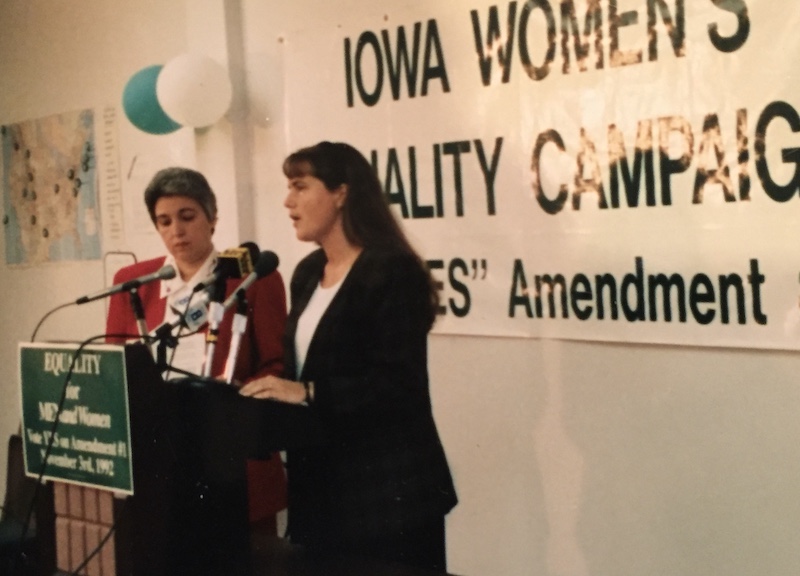
Women’s equality champion Representative Carolyn Maloney wrote in The Hill this week about the imperative of adopting the Equal Rights Amendment to the United States Constitution:
In 1971 — exactly 50 years ago — the indomitable feminist and fellow New Yorker, Rep. Bella Abzug, introduced a bill to establish Aug. 26 as Women’s Equality Day. The holiday commemorates the Aug. 26, 1920 certification of the Nineteenth Amendment, which granted women the right to vote.
But suffrage was never the final goal of our feminist foremothers. After the Nineteenth Amendment was ratified 101 years ago, suffragist leader Alice Paul, who is a relative of my late husband, immediately went to work to write the Equal Rights Amendment (ERA). She believed the ERA was the essential next step towards achieving gender equality in this country. In 1920, she said, “It is incredible to me that any woman should consider the fight for full equality won. It has just begun.”
The ERA was first introduced in Congress in 1923, and the amendment was re-introduced in every session of Congress until 1972. With the women’s equality movement at the forefront, on Oct. 12, 1971, the U.S. House of Representatives passed the ERA by an overwhelming bipartisan vote of 354‐23 to enshrine gender equality into the Constitution. The Senate passed the ERA in 1972, and Congress sent it to the states for ratification. Alice Paul fought for the ERA until she was on her deathbed in 1977. Unfortunately, in 1982 the congressionally extended timeline expired, and the ERA stalled — only three states short of ratification.
Fortunately, some of us never gave up on the amendment, and as a result, the ERA has had a modern renaissance. Over the last four years, Nevada, Illinois, and Virginia have all ratified the ERA, bringing us to the 38 states needed for ratification. Yet because of a questionable legal opinion issued by the Trump administration, the ERA has still not been certified. We are still waiting, just like our suffragist mothers before us, for our rights to be permanently enshrined in the U.S. Constitution.
Women’s equality cannot wait another century. That’s why I have been proud to join over 200 of my congressional colleagues on a bill to remove the arbitrary deadline from the ERA. In March 2021, I also re-introduced the ERA in the House, as I have in every session of Congress since 1997. Equal rights for women are necessary in every democracy, and I will not stop until we finally see ourselves reflected in our most foundational document.
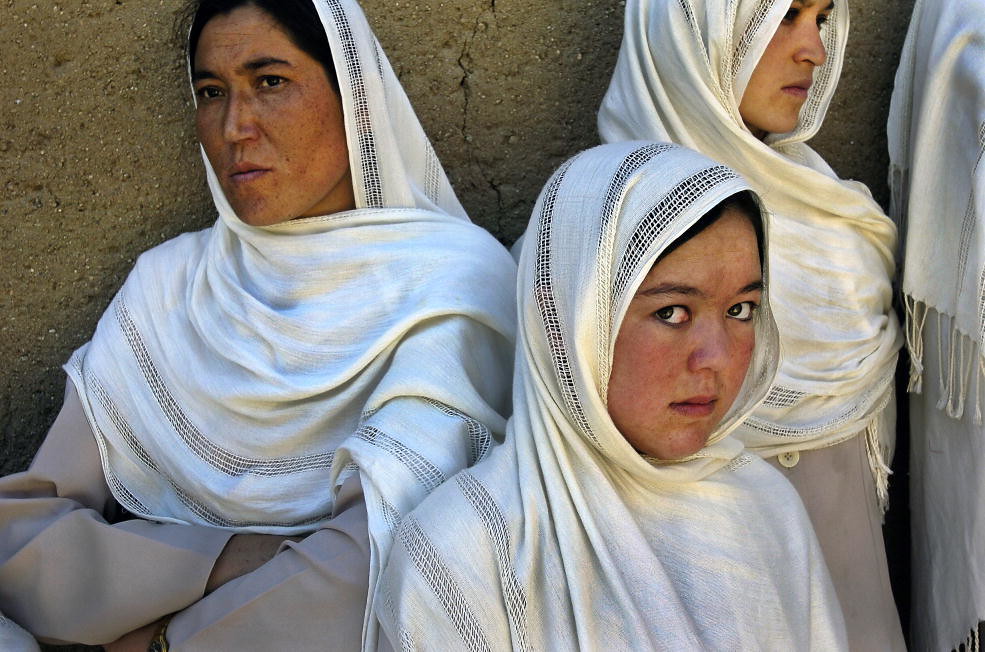
Alyse Nelson, CEO of Vital Voices, are among those leading efforts to help women in Afghanistan while new stories emerge every day about the peril women are facing there. This piece by Lynne O’Donnell in Foreign Policy reports on the desperate situation for women in Afghanistan now that the last U.S. military personnel have left and the Taliban is now in charge:
As the Taliban consolidate control over their new Islamic emirate in Afghanistan, women have largely disappeared from public as extremists force them from their jobs and into their homes, bringing an end to 20 years of progress toward freedom and equality.
Human rights activists say they are still unsure if the Ministry of Women’s Affairs will reopen once the Taliban come to grips with the needs of running the country. In the meantime, international support for programs for women has been suspended, and sources in the sector cannot say when or if it will resume.
Almost two weeks after the fall of Kabul, little is understood of how the group intends to govern. They have talked about an “inclusive” government, and sources close to the leadership have said a 12-man council will rule. But so far, most appointments have gone to mullahs—religious men with no experience running ministries, provinces, or even hotels.
Some Afghan sources said suicide attacks at the gate of Kabul’s airport on Thursday, which killed more than 100 people, including 13 U.S. service members, were aimed at discouraging people with education from leaving the country as they will be essential once the country reopens. Although the local Islamic State branch claimed responsibility for the attacks, some Afghans suspect the Haqqani network, closely aligned with the Taliban and in control of security in Kabul, was the more likely perpetrator.

The sheer number of Afghan women and girls impacted by the current crisis is staggering but this article in The Washington Post by Ellen Francis helps to put a face and name to the experiences so many women are facing:
Fawzia Koofi spent years fighting for women’s rights in Afghanistan. She survived at least two assassination attempts and then last year sat face-to-face with Taliban leaders to negotiate the country’s future.
But the former Afghan legislator, who once hoped to run for president, finally left Kabul on Monday night on one of the last evacuation flights, despite the Taliban militants who had placed her under house arrest — and who now control her home.
Hours after landing in the Persian Gulf nation of Qatar, the outspoken Taliban critic said Afghanistan feels unsafe now but pledged to return one day.
“It was heartbreaking to see how everything collapsed,” she said in a BBC radio interview Tuesday.
“I was afraid of being oppressed, of staying under house arrest, not that those people would kill me,” Koofi added. “I never wanted to leave. … To leave in a situation where you think thousands, maybe millions of people, are desperate and hopeless … to leave those people, emotionally, I felt so inappropriate.”
Koofi, born in a remote province in the northeast, was the first girl in her family to go to school and went on to become the first female deputy speaker of Afghanistan’s parliament.
Last year, she was one of a few women chosen to take part in the U.S.-backed government’s attempt to negotiate with the Taliban. The two sides held talks after the Trump administration clinched a deal with the Islamist militants that spelled out the terms of the U.S. withdrawal from Afghanistan.
In recent weeks, Koofi joined the chorus of criticism over how the United States handled the pullout of its troops without a political deal.
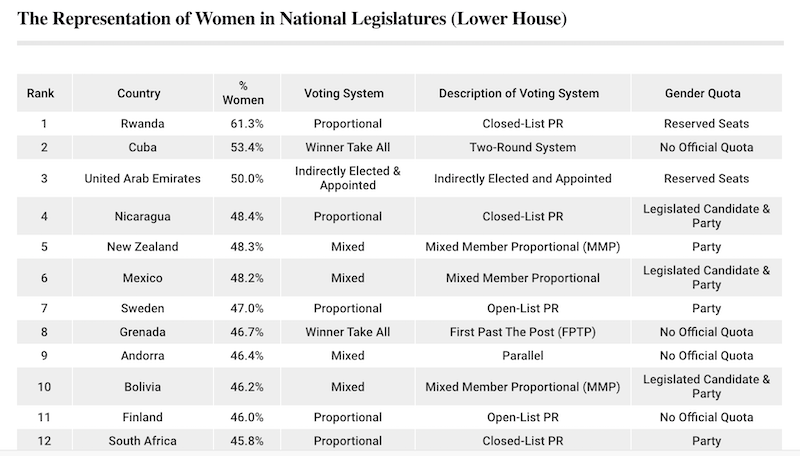
While there are many challenges facing South Africa, it ranks 12th among all countries for the percentage of women in the lower house of parliament due to a highly effective formula of proportional representation and gender quotas that ensure women have opportunities to participate in politics. The exact date for the next election remains unclear but Jennifer Smout writes a detailed piece about electoral rules in South Africa that impact women’s representation:
South Africa is often lauded globally for its gender representation in government. As of June 2021, the Inter-Parliamentary Union ranks South Africa 11th in the World for women’s representation at a parliamentary level, the second-highest in Africa (after Rwanda). Similarly, the World Economic Forum’s annual Global Gender Gap Report scored South Africa 14th in the world in terms of political empowerment in 2021.
Whilst these achievements are certainly impressive, they do not measure up to South Africa’s international commitments. In 2008, South Africa signed the Southern African Development Community (SADC) Protocol on Gender and Development and ratified it in 2012. Article 12 of the protocol commits States Parties to achieve 50% representation of women in decision-making bodies in the public and private sectors by 2015. Six years after that due date, South Africa is yet to achieve the 50:50 target, or to introduce any compulsory special measures to encourage political parties to do so. Performance is worst at the local government level.
There are no legal barriers to women’s participation in elections or to them becoming representatives for political parties. Women register and turn out to vote in higher numbers in national, provincial, and local elections. But, at the local government level, women’s representation has stagnated, particularly at the ward level. In 2016, just 33% of ward councillors elected were women, whereas 48% of Proportional Representation Councillors were female.
More often than not, what determines whether women are elected and represented at any level of government is party lists and these rarely include equal numbers of men and women. Only two parties, the ANC and the EFF, have voluntary quotas for party lists but in the last local government elections, even these parties failed to meet their own goals.
Dr Thabo Rapoo, Head of Research at the Commission for Gender Equality suggests that it is institutionalised political patriarchy that limits progress in this regard. “A key barrier is internal party-political practices and the willingness to see women as party leaders, or in leadership positions. Local government structures are ward-based and the ward position is the one that women are finding it hard to break through — proportional representation (PR) positions are defined by the party, so they can determine who is on the list. Local contexts and constituencies that are patriarchal will make it more difficult for women to win positions or nominations to ward and local levels. Those local party structures that candidates have to go through and be vetted still tend to be dominated by males or male power brokers who make it difficult for them to get through such structures. Patriarchy in parties reflects what is on the ground.”
Data from Gender Links from 2016 highlights the stark gender gaps. Although the proportion of women candidates on party lists increased from 37% in 2011 to 41% in 2016 political parties listed fewer women candidates at ward level.
According to Gender Links, “this is singularly responsible for SA not achieving gender equality in the elections.” The highest proportion of women on ward candidate lists was 44% (Cope), with all other parties having less than 40% women, and the IFP (24%) and FF+ (22%) having the lowest representation of women. At the PR level, the representation of women on lists was better, however, only two parties had a majority of women on their lists — the ANC with 61% and the EFF with 60%. Gender Links’ report concludes “in the absence of a quota mechanism, South Africa relies entirely on the commitment of individual political parties to promote women’s representation.”
In other countries, quotas for gender in government have worked to promote more equitable gender representation — at least on the descriptive level. In Africa, women’s representation at local level is highest in PR electoral systems with a constitutional or legislated quota, for example, Namibia and Lesotho. But whether quotas for women’s representation would make much of a difference to South Africa’s gender representation at this level is unclear.
“The CGE supports the introduction of a quota,” says Rapoo, “but quotas must include the zebra stripe principle”, that is, men and women at alternate places on the list. If number one on the list is a male, then number two must be female and so on. “Without the zebra stripe principle, if you have a quota of just 50 50, often a party can put all the women candidates at the bottom of the list, which ultimately affects the chances they have of getting a position.”
Gouws, in contrast, is sceptical. “The voluntary quota of the ANC makes no difference and most of the other parties (those with less than 1% of the vote) are too small — they may only have one or two candidates. A quota may, however, force parties like the DA and EFF to consider more women” says Gouws. In the 2016 elections, the DA fielded 35% female candidates on ward lists, and 34% on their PR list — the second-lowest proportion of any party.
Whether those women who are represented actually promote the interests of gender equality, or have a duty to, is a far more complex question. Descriptive equality has not always translated to substantive equality, or a meaningful improvement in women’s lives.
Voters in Boston will elect a new mayor on November 2, but the large field of candidates running under winner-take-all rules is a reminder of the dangers of split votes among like candidates and the perils of plurality winners whom the majority of voters did not support.
Lisa Kashinsky, a Boston-based author, writes in Politico about the complexity of the race:
After nearly 200 years of being led by white men, Boston could have its first female mayor, its first Black mayor, its first Asian-American mayor or its first Arab-American mayor this fall. Four of the five major candidates are multi-term city councilors, and the fifth spent seven years as former mayor Marty Walsh’s economic development chief. As it stands, the four leading candidates are women.
The deep well of experienced, non-white candidates is widely cheered within the city’s Democratic apparatus. But the same milestone is proving challenging to navigate — dividing progressive activists and bringing up tough conversations within Boston’s Black community, where leaders have worked for decades to elevate one of their own to the city’s highest office.
“It feels like a breakthrough moment and such a sea change,” state Sen. Sonia Chang-Díaz, a Latina and Democrat running to be the state’s first elected female governor, said of the mayor’s race. She said the choice will be “a joy” for voters — “particularly voters who care about racial and ethnic justice, and the advancement of women and the progressive agenda.”
Several politicians called it an “embarrassment of riches” — a level of diversity that’s been years if not decades in the making in a city with a notoriously racist past.
But the nature of this year’s race presents choices that are equally as unprecedented for the city’s political class. And that’s leading to tough conversations, most publicly and prominently among the city’s progressive activists and Black leaders, with less than three weeks left until the Sept. 14 preliminary, nonpartisan election that will cull the field down to two.
In contrast to the plurality rules in Boston, a number of cities in Utah are gearing up to use ranked-choice voting this fall. According to this piece in the Cache Valley Daily two dozen cities have adopted RCV and will be using it for municipal elections in November:
In 2018, the Utah Legislature approved a pilot program to allow cities, towns and counties to conduct local elections using ranked-choice voting. Until now, only Utah County and the small municipalities of Payson and Vineyard had taken advantage of that option.
Now, with Salt Lake City leading the way, nearly two dozen Utah municipalities have opted for ranked-choice voting in the upcoming general election.
The immediate impact of that decision was to allow those towns and cities to avoid the administrative burden and expense of conducting primary balloting on Aug. 10.
In fact, the official deadline for candidate registrations in Newton, Nibley and River Heights was deferred until Aug. 17.
Advocates of ranked-choice voting argue that option is the most efficient and accurate way to understand the voice of the people. That voting procedure not only saves jurisdictions money by preventing costly run-off elections, they say, but also reduces negative campaigning. Moreover, ranked-choice voting is reputed to guarantee that the majority of voters will at least approve of the winner in a crowded field of candidates.
“Crowded” is certainly the best description of the fields of candidates in Newton, Nibley and River Heights.
Check out this week’s suggested feminist reading from the team at RepresentWomen:
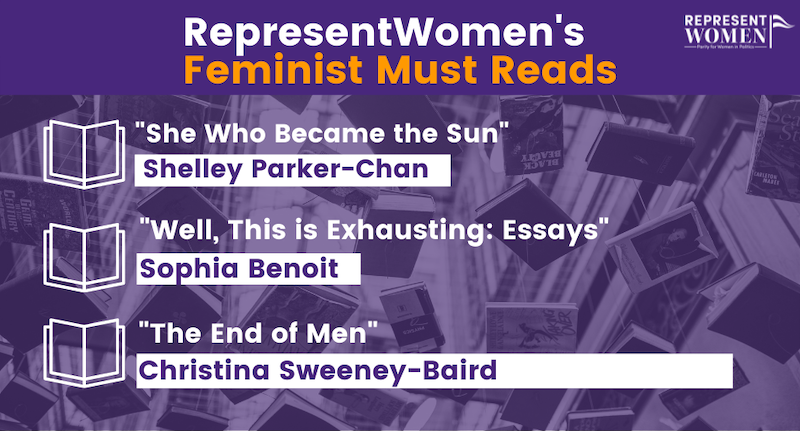
The cooler temperatures in Washington, D.C., bring asters and anemones along with butterflies on zinnias and lemon cake!
Up next:









